2009 AUDI TT COUPE child restraint
[x] Cancel search: child restraintPage 170 of 316
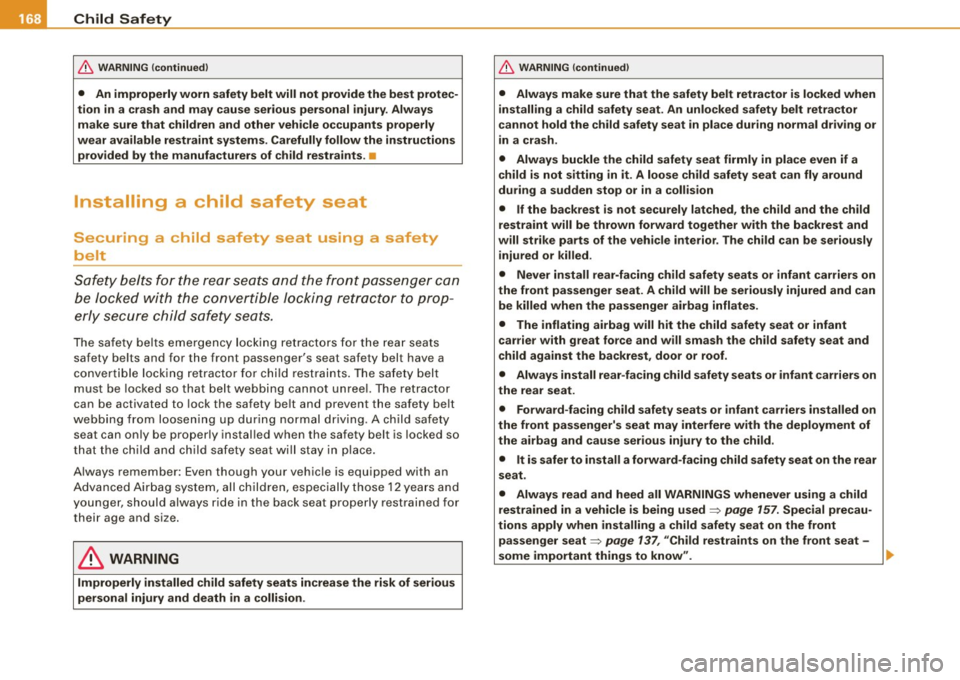
___ C_h_ i_ ld _ S_ a_ f_ e_ t_y ____________________________________________ _
& WARNING (continued )
• An improperly worn safety belt will not provide the best protec
tion in a crash and may cause serious personal injury . Always
m ake sure that children and other veh icle occupants properly
wear available restraint sy stem s. Carefully follow the instructions
provided by the manufacturers of child restraints . •
Installing a child safety seat
Securing a child safety seat using a safety
belt
S afety belts f or the rear sea ts an d the front pa ssenger can
b e l ocke d wit h th e co nv erti ble lockin g ret racto r to p rop
erly secu re c hild safety sea ts.
The safe ty be lts eme rgency loc king re tr acto rs for th e rea r s eat s
saf ety belts an d for t he front pass enger's seat safety be lt have a
co nve rtible lock ing retracto r for c hild r estra int s. The sa fet y b elt
must be loc ked so t hat belt we bbing cannot u nre el. T he r etrac to r
can be activated to lock the safety be lt and prevent the safety be lt
w eb bing fr om l oos enin g up dur ing n ormal dr ivi ng . A ch ild safe ty
seat can only be properly instal led when the safety belt is locked so
th at the chi ld and chi ld sa fety seat will st ay in pla ce.
Al ways rem embe r: Even t hough you r vehic le is equ ipped with an
A dva nced Airb ag s ystem, a ll chil dre n, esp ecia lly th ose 12 yea rs and
youn ger, s hou ld always ri de in the back seat prop erly rest rained for
thei r age and size .
& WARNING
Improperly installed child safety seats increase the risk of serious
personal injury and death in a collision .
& WARNING (continued)
• Always make sure that the safety belt retractor is locked when
installing a child safety seat . An unlocked safety belt retractor
cannot hold the child safety seat in place during normal driving or
in a crash.
• Always buckle the child safety seat firmly in place even if a
child is not sitting in it . A loose child safety seat can fly around
during a sudden stop or in a collision
• If the backrest is not securely latched, the child and the child
restraint will be thrown forward together with the backrest and
will strike parts of the vehicle interior . The child can be seriously
injured or killed .
• Never install rear-facing child safety seats or infant carriers on
the front passenger seat . A child will be seriously injured and can
be killed when the passenger airbag inflates .
• The inflating airbag will hit the child safety seat or infant
carrier with great force and will smash the child safety seat and child against the backrest, door or roof .
• Always install rear -facing child safety seats or infant carriers on
the rear seat.
• Forward-facing child safety seats or infant carriers installed on
the front passenger's seat may interfere with the deployment of
the airbag and cause serious injury to the child.
• It is safer to install a forward-facing child safety seat on the rear
seat .
• Always read and heed all WARNINGS whenever using a child
restrained in a vehicle is being used=> page
157 . Special precau
tions apply when installing a child safety seat on the front passenger seat=> page
137, "Child restraints on the front seat -
some important things to know" . ._
Page 171 of 316
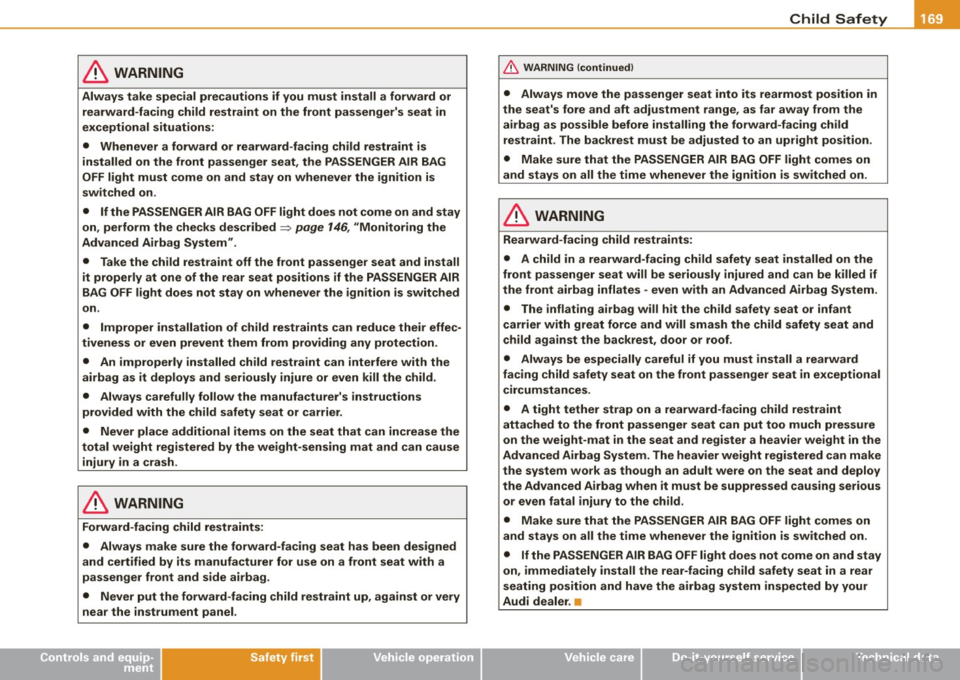
____________________________________________ __:C:::. h :....:..:..:. il.:::d ~S :::.:::a.:.:fe :::. t:.! y~ _ffllll
& WARNING
Always take special precautions if you must install a forward or
rearward -facing child restraint on the front passenger's seat in
exceptional situations:
• Whenever a forward or rearward -facing child restraint is
installed on the front passenger seat , the PASSENGER AIR BAG
OFF light must come on and stay on whenever the ignition is
switched on.
• If the PASSENGER AIR BAG OFF light does not come on and stay
on , perform the checks described
=> page 146, "Monitoring the
Advanced Airbag System".
• Take the child restraint off the front passenger seat and install
it properly at one of the rear seat positions if the PASSENGER AIR
BAG OFF light does not stay on whenever the ignition is switched
on .
• Improper installation of child restraints can reduce the ir effec
tiveness or even prevent them from providing any protection .
• An improperly installed ch ild restraint can interfere with the
airbag as it deploys and seriously injure or even kill the child.
• Always carefully follow the manufacturer's instructions
provided with the child safety seat or carrier.
• Never place additional items on the seat that can increase the
total weight registered by the weight-sensing mat and can cause
injury in a crash .
& WARNING
Forward-facing child restraints:
• Always make sure the forward -facing seat has been designed
and certified by its manufacturer for use on a front seat with a
passenger front and side airbag .
• Never put the forward -facing child restraint up , against or very
near the instrument panel .
Controls and equip ment Safety first
Vehicle operation
& WARNING (continued )
• Always move the passenger seat into its rearmost position in
the seat's fore and aft adjustment range, as far away from the airbag as possible before installing the forward-facing child
restraint. The backrest must be adjusted to an upright position .
• Make sure that the PASSENGER AIR BAG OFF light comes on
and stays on all the time whenever the ignition is switched on.
& WARNING
Rearward -facing child restraints :
• A child in a rearward -facing child safety seat installed on the
front passenger seat will be seriously injured and can be killed if
the front airbag inflates -even with an Advanced Airbag System .
• The inflating airbag will hit the child safety seat or infant
carrier with great force and will smash the child safety seat and
child against the backrest , door or roof .
• Always be especially careful if you must install a rearward
fac ing child safety seat on the front passenger seat in e xceptional
circumstances .
• A tight tether strap on a rearward-facing child restraint
attached to the front passenger seat can put too much pressure
on the weight-mat in the seat and register a heavier weight in the
Advanced Airbag System. The heavier weight registered can make
the system work as though an adult were on the seat and deploy
the Advanced Airbag when it must be suppressed causing serious or even fatal injury to the child .
• Make sure that the PASSENGER AIR BAG OFF light comes on
and stays on all the time whenever the ignition is sw itched on .
• If the PASSENGER AIR BAG OFF light does not come on and stay
on , immediately install the rear-fac ing child safety seat in a rear
seating position and have the airbag system inspected by your
Audi dealer. •
Vehicle care Do-it-yourself service Technical data
Page 172 of 316

___ C_ h_ il_ d _S_ a_fe _ ty ______________________________________________ _
Activating the convertible locking retractor
Use the convertible locking retractor to secure a child
restraint.
Always heed the child safety seat manufacturer's instruc
tions when installing a ch ild restraint in your vehicle. To
activate the convertible locking retractor:
- Place the child restraint on a seat, preferably on the rear
seat.
- Slowly pull the belt
all the way out .
-Route it around or through the child restraint belt path
=>& -
- Push the child safety seat down with your full weight to
get the safety belt really tight.
- Insert the belt tongue into the buckle for that seating
position.
- Guide the safety belt back into the retractor unt il the belt
lies flat and snug on the child safety seat .
- You should hear a "clicking" noise as the belt winds back
into the inertia reel. Test the convertible locking retractor
by pulling on the belt. You should no longer be able to
pull the belt out of the retractor. The convertible locking
retractor is now act ivated.
- Make sure that the red release button is facing away from
the child restraint so that it can be unbuckled quickly.
- Pull on the belt to make sure the safety belt is properly
tight and fastened so that the seat cannot move forward or sideways more than one inch (2 .5 cm) .
& WARNING
Using the wrong child restraint or an improperly installed child
restraint can cause serious personal injury or death in a crash.
• Always make sure that the safety belt retractor is locked when
installing a child safety seat. An unlocked safety belt retractor
cannot hold the child safety seat in place during normal driving or
in a crash.
• Always buckle the child safety seat firmly in place even if a
child is not sitting in it. A loose child safety seat can fly around
during a sudden stop or in a crash.
• Always make sure the seat backrest to which the child restraint
is installed is in an upright position and securely latched into place
and cannot fold forward. Otherwise, the seat back with the child
safety seat attached to it could fly forward in the event of an acci
dent or other emergency situation.
• Always read and heed all WARNINGS whenever using a child
restrained in a vehicle is being used=>
page 157. Special precau
tions apply when installing a child safety seat on the front
passenger seat=>
page 137, "Child restraints on the front seat -
some important things to know" .•
Deactivating the convertible locking retractor
The convertible locking retractor for child restraints will
be deactivated automatically when the belt is wound all
the way back into the retractor.
-Press the red button on the safety belt buckle. The belt
tongue will pop out of the buckle.
- Guide the belt all the way back into its stowed position .
Always let the safety belt retract completely into its stowed position.
The safety belt can now be used as an ordinary safety belt without
the convertible locking retractor for child restraints.
IJll-
Page 173 of 316

Child Safety -
--------------------''---
If the convertible locking retractor should be activated inadvert
ently, the safety belt must be unfastened and gu ided co mple te ly
back into its stowed position to deactivate this feature. If the
convertible lock ing retractor is not deactivated, the safe ty be lt will
gradually become tighter and uncomfortab le to wear.
& WARNING
Improper ly in stalled child safet y seat s in crea se the risk of seri ous
personal injury and death in a colli sion.
• Never unfasten t he safety belt to d eactivate the c onvertible
locking retractor for child re straint s while the vehicle is moving .
You would not be re strained and could be seriou sly injured in an
accid ent.
• Alway s re ad and heed all WARNINGS whenever us ing a child
restrained in a vehicle is being used=:>
page 15 7. Spec ial precau
tion s app ly when in stalling a child safety se at on the fr ont
p assen ger seat =:>
pag e 13 7, "Child re straint s on the front seat -
s ome important thing s to know ".•
Additional Information
What types of child restraint anchors are
available and how are they related to child
safety?
For years, child restraints have been installed using the safety belts
a lready present i n every vehicle.
Since September 1, 1999, chi ld restraint manufacturers have been
providing tether straps that attach the top of the child restraint to
the vehicles structure, on most of their forward -facing systems in
order to comply with U.S. Federa l regu lations for child restraint
performance in a crash. Vehicle manufacture rs are required to
Controls and equip
ment Safety first Vehicle operation
phase-in tether anchorages for attachment of the tether strap in
t heir U.S. vehic les beg inn ing September 1, 1999 .
The combination of the tether anchorages and the lower anchor
ages is now genera lly called the
LATCH system for " Lower Anchors
and Tether for C hildren".
( T he term "ISOFIX" regarding lower anchorages had been used by
Audi and other manufacturers in t he pas t, but LATCH is now the
standard name for the new child restraint anchorage system.)
Some child restraint system manufacturers have been providing
tether straps on certain models o f their child restraint systems,
either as standard equipment or as a retrofit, for severa l years.
Check w ith the manufacturer of the child restraint sys te m f or tether
strap availabi lity.
To provide a simpler and more practicable way to attach the child restraint system on the vehicle seat, U.S . Federal regu lations require
t he phase -in of lower anchorages in veh icles an d devices on new
child restraint systems to attach to the veh ic le ancho rages .
Child restraint system manufacturers will probably offer two kinds
of lower anchorages on their child safety seats
They cou ld come with:
• hook-on or push-on connectors attached to adjustable straps or
• rigid latches on bars that extend out the back of the child
restraint and are released with re lease buttons at the bottom of the
child restraint.
I n addition to the LATCH lower anchorages, both of these child
restra int systems use tether straps to help keep the chi ld restraint
system firmly in p lace. •
Where can I get additional information about
child restraint application and usage?
There are a numbe r of sources of additional information about child
restra int select ion, installation and usage: _.,
Vehicle care Do-it-yourself service Technical data
Page 174 of 316
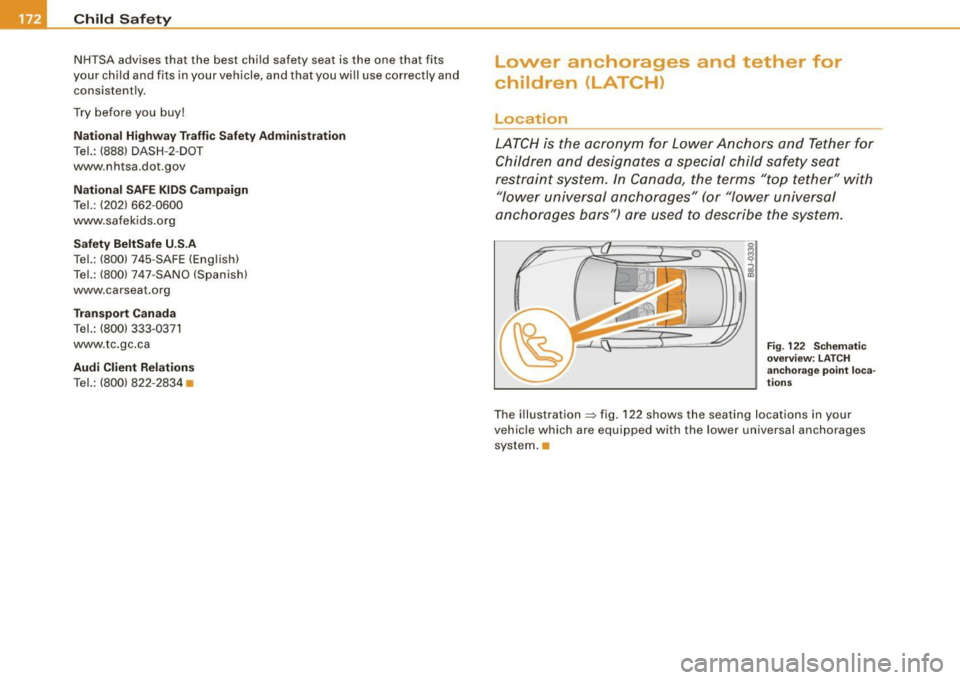
__ _:C~ h~il ~d ~ S~ a~fe ~t~ YL _________________________________________ _
NHTSA advises that the best child safety seat is the one that fits
your child and fits in your vehicle, and that you will use correctly and consistently.
Try before you buy!
National Highway Traffic Safety Administration
Tel.: (888) DASH -2 -DOT
www .nhtsa.dot.gov
National SAFE KIDS Campaign
Tel.: (202) 662 -0600
www.safekids.org
Safety BeltSafe U.S.A
Tel.: (800) 745-SAFE (English)
Tel.: (800) 747 -SANO (Spanish)
www.carseat.org
Transport Canada
Tel.: (800) 333-0371
www.tc.gc.ca
Audi Client Relations
Tel.: (800) 822-2834 • Lower anchorages and tether for
children (LATCH)
Location
LATCH is the acronym for Lower Anchors and Tether for
Children and designates a special child safety seat
restraint system. In Canada, the terms "top tether" with
"lower universal anchorages" (or "lower universal
anchorages bars") are used to describe the system.
Fig . 122 Schematic
overview: LATCH
anchorage point loca
tions
The illustration =:> fig. 122 shows the seating locations in your
vehicle which are equipped with the lower universal anchorages system. •
Page 175 of 316
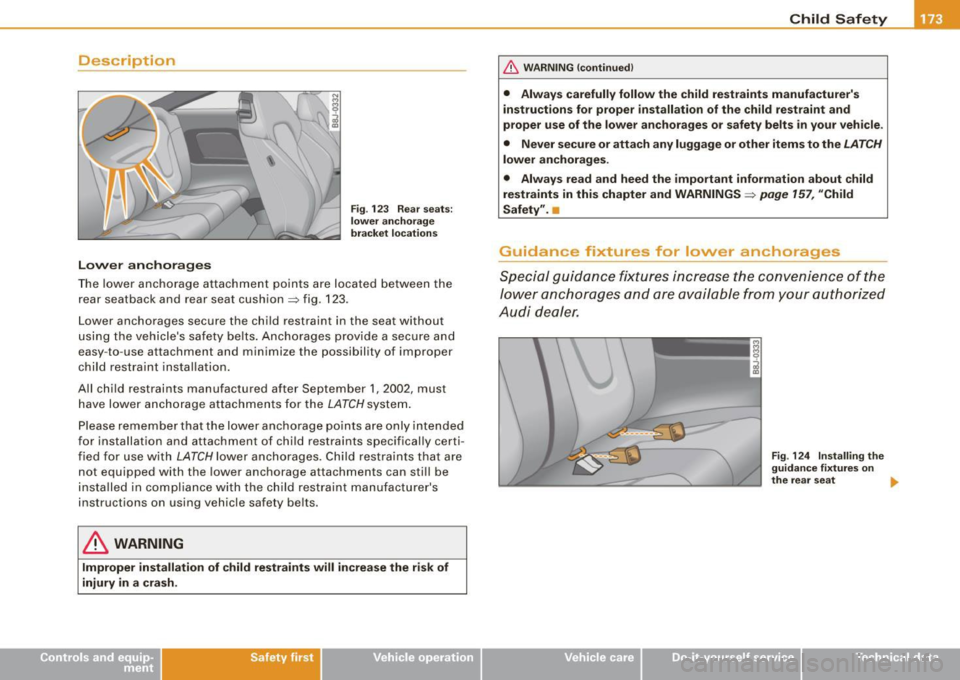
Description
Lower anchorages
Fig. 123 Rear seats:
lower anchorage
bracket locations
The lower anchorage attachment points are located between the
rear seatback and rear seat cushion~ fig. 123.
Lower anchorages secure the child restraint in the seat without
using the vehicle 's safety belts. Anchorages provide a secure and
easy -to -use attachment and minimize the possibility of improper
child restraint installation.
All child restraints manufactured after September 1, 2002, must have lower anchorage attachments for the
LATCH system.
Please remember that the lower anchorage points are only intended
for installation and attachment of child restraints specifically certi
fied for use with
LATCH lower anchorages . Child restraints that are
not equipped with the lower anchorage attachments can still be
installed in compliance with the child restraint manufacturer's
instructions on using vehicle safety belts.
,& WARNING
Improper installation of child restraints will increase the risk of
injury in a crash.
Safety first
Child Safety
& WARNING (continued)
• Always carefully follow the child restraints manufacturer's
instructions for proper installation of the child restraint and
proper use of the lower anchorages or safety belts in your vehicle.
• Never secure or attach any luggage or other items to the
LATCH
lower anchorages.
• Always read and heed the important information about child
restraints in this chapter and WARNINGS~
page 157, "Child
Safety". •
Guidance fixtures for lower anchorages
Special guidance fixtures increase the convenience of the
lower anchorages and are available from your authorized
Audi dealer.
Vehicle care I I
Fig . 124 Installing the
guidance fixtures on
the rear seat •
irechnical data
Page 176 of 316
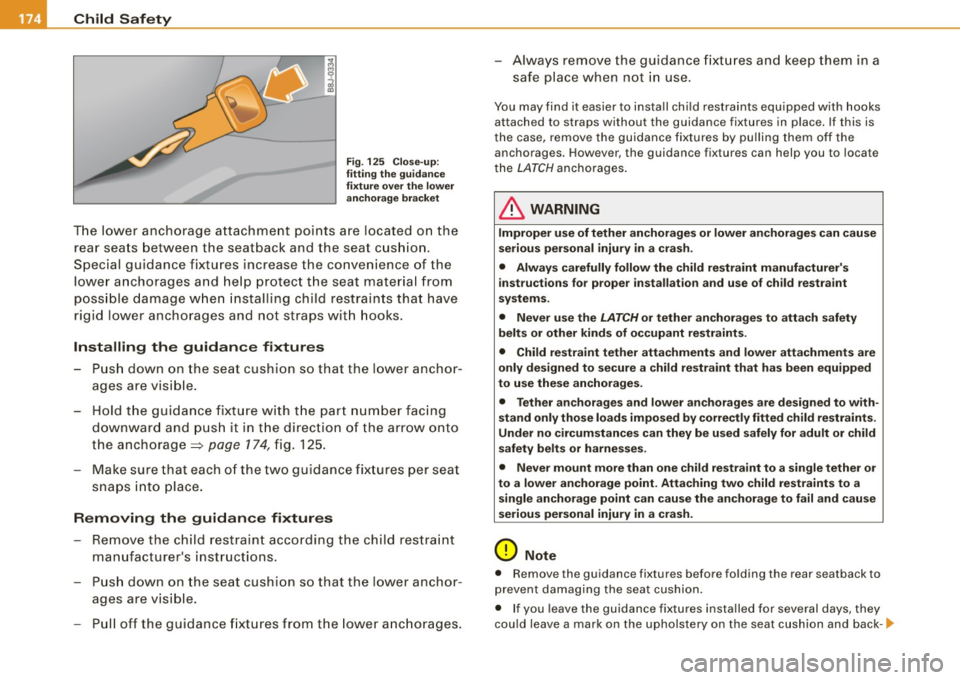
___ C_h_ i_ ld _ S_ a_ f_ e_ t_y ____________________________________________ _
Fig. 125 Close-up:
fitting the guidance
fixture over the lower
anchorage bracket
The lower anchorage attachment points are located on the
rear seats between the seatback and the seat cushion .
Special gu idance fixtures increase the convenience of the
lower anchorages and help protect the seat material from
possible damage when installing ch ild restraints that have
rigid lower anchorages and not straps with hooks.
Installing the guidance fixtures
- Push down on the seat cushion so that the lower anchor
ages are visible.
- Hold the guidance fixture with the part number facing
downward and push it in the direction of the arrow onto
the anchorage =>
page 174, fig. 125.
- Make sure that each of the two guidance fixtures per seat
snaps into place.
Removing the guidance fixtures
-Remove the child restraint according the child restraint
manufacturer's instructions.
- Push down on the seat cushion so that the lower anchor
ages are visible.
- Pull off the guidance fixtures from the lower anchorages. - Always remove
the guidance fixtures and keep them in a
safe place when not in use.
You may find it easier to install child restraints equipped with hooks
attached to straps without the guidance fixtures in plac e. If this is
the case , remove the guidance fixtures by pulling them off the
anchorages . However , the guidance fixtures can help you to locate
the
LATCH anchorages .
& WARNING
Improper use of tether anchorages or lower anchorages can cause
serious personal injury in a crash.
• Always carefully follow the child restraint manufacturer's
instructions for proper installation and use of child restraint
systems.
• Never use the
LATCH or tether anchorages to attach safety
belts or other kinds of occupant restraints.
• Child restraint tether attachments and lower attachments are
only designed to secure a child restraint that has been equipped
to use these anchorages .
• Tether anchorages and lower anchorages are designed to with
stand only those loads imposed by correctly fitted child restraints.
Under no circumstances can they be used safely for adult or child
safety belts or harnesses.
• Never mount more than one child restraint to a single tether or
to a lower anchorage point. Attaching two child restraints to a single anchorage point can cause the anchorage to fail and cause
serious personal injury in a crash.
0 Note
• Remov e the guidance fixtur es before folding th e rear se atback to
prevent damaging the seat cushion.
• If you leave the guidance fixtures installed for several days, they
could leave a mark on the upholstery on the seat cushion and back-~
Page 177 of 316

rest in the area that the guidance fixtures were installed. The uphol
stery would also be permanently stretched around the guidance
fixtures. This applies especially to leather seats.
[ i J Tips
• Always remove the guidance fixtures when not in use .
• Please keep the guidance fixtures in a safe place with the vehicle
when not in use.•
Installing a child restraint using the lovver
anchorages of the LATCH system
Child safety seats equipped with the LATCH system can
quickly and easily be secured to the rear seats.
Safety first
Fig . 126 LATCH-type
seat with both rigid
latch bars extended
Child Safety
Fig. 127 Installation of
child safety seat with
rigid latches on bars
Whenever you install a child restraint always refer to the
child restraint manufacturer's instructions.
- Make sure the seat back of the rear seat bench is in the
upright position and securely latched in place.
- Install the guidance fixtures==>
page 173.
Insert the latches onto the lower anchorages==> fig. 127.
- Make sure you hear the child restraint click securely into
place. This indicates that the seat is securely mounted on
the anchors.
- Pull on the child restraint once you have mounted it to
make sure it is secure.
& WARNING
Improper use of the LATCH system can increase the risk of serious
personal injury and death in an accident.
• These anchors were developed solely for child safety seats
using the "LATCH" system.
• Never attach other child safety seats, belts or other objects to
these anchors.
• Always make sure that you hear a click when latching the seat
in place. If you do not hear a click the seat is not secure and could .,
Vehicle care I I irechnical data